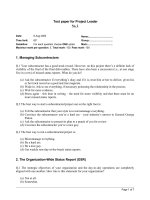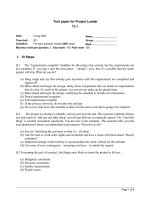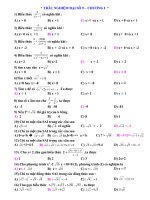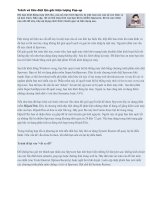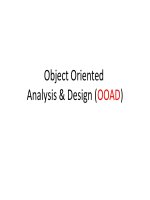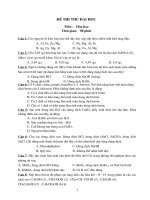Automatic paper pop up design
Bạn đang xem bản rút gọn của tài liệu. Xem và tải ngay bản đầy đủ của tài liệu tại đây (25.61 MB, 56 trang )
AUTOMATIC PAPER POP-UP DESIGN
LEOW SU JUN
(B. Comp. (Hons.). NUS
THESIS SUBMITTED
FOR THE DEGREE OF MASTER OF SCIENCE
SCHOOL OF COMPUTING
NATIONAL UNIVERSITY OF SINGAPORE
2010
1
I would like to thank Dr Low Kok Lim for his guidance and supervision. Credit
also goes to Mr Liu Linlin for his implementation of the support algorithm. Lastly,
I would also like to thank Professor Tan Tiow Seng, Dr. Michael Brown, and Dr.
Alan Cheng for all their invaluable comments.
2
Contents
1
Introduction
9
2
Challenges and Approach
13
2.1
Challenge (1): Geometry Selection . . . . . . . . . . . . . . . . . . 13
2.2
Challenge (2): Geometry Conversion . . . . . . . . . . . . . . . . . 16
3
Related Work
20
4
OA Design Algorithm
23
5
4.1
Extracting Relevant Geometry . . . . . . . . . . . . . . . . . . . . . 24
4.2
Surface Segmentation . . . . . . . . . . . . . . . . . . . . . . . . . . 25
4.3
Surface Slicing . . . . . . . . . . . . . . . . . . . . . . . . . . . . . . 27
4.3.1
Choosing Slice Orientation . . . . . . . . . . . . . . . . . . 28
4.3.2
Downsampling . . . . . . . . . . . . . . . . . . . . . . . . . 28
4.3.3
Upsampling . . . . . . . . . . . . . . . . . . . . . . . . . . . 30
4.4
Adding Supports . . . . . . . . . . . . . . . . . . . . . . . . . . . . . 32
4.5
Correcting Boundaries . . . . . . . . . . . . . . . . . . . . . . . . . . 41
4.6
Generating OA Plan . . . . . . . . . . . . . . . . . . . . . . . . . . . 43
Experimental Results
5.1
44
Our Results . . . . . . . . . . . . . . . . . . . . . . . . . . . . . . . . 44
3
5.2
Comparison . . . . . . . . . . . . . . . . . . . . . . . . . . . . . . . . 45
6
Limitations
51
7
Conclusion
53
4
We present a computational method capable of designing complex Origamic Architecture (OA) report pop-ups that closely depict the given 3D objects, which are
input as digital 3D models. OA is a form of paper craft involving paper cutting
and folding to produce pop-up models of objects. Our method targets a common
type of OA in which each pop-up must be one single connected sheet of paper,
and all the folds must be 90 degrees. These strict geometric requirements make
the pop-up design difficult for most people.
Our method fully automates the design process, using raster graphics rendering
and 2D image processing to produce pop-up designs for the input models. We
render an orthographic view of the model from a view direction 45 degrees above
the horizon to obtain a depth map. The rendering automatically removes irrelevant geometry, and the use of the 45-degree view direction offers many critical
benefits. The depth map is then transformed to a valid pop-up plan using only one
single conversion rule that can be applied indiscriminately regardless of the input
surface types. The conversion consists of a depth quantization step and a structure
correction step, and together they produce a valid 2D OA plan that can be cut and
folded to construct the pop-up. Our image-domain approach avoids direct 3D geometry processing of the input model, and thus averts many potential degeneracy
and robustness issues.
Very little input is required from the user. The user can control the degree of intricacy of the pop-up by specifying a minimum gap size between cuts and folds.
Even though very limited aesthetic control is provided, in many cases, our system has been successful in producing valid, beautiful and intricate pop-ups for
complex objects.
5
List of Figures
1.1
(a) and (d) The input 3D object models of the Colosseum and
the Rialto Bridge. (b) and (e) The 2D OA plans generated by
our system. The red lines are the cut lines and green lines the
fold lines. (c) and (f) The computer-generated OA pop-up models
constructed from the OA plans. . . . . . . . . . . . . . . . . . . . . .
9
1.2
Elements in an OA pop-up. . . . . . . . . . . . . . . . . . . . . . . . 12
1.3
Invalid faces: (left) a floating face, and (right) a dangling face. . . . 12
2.1
3D pop-up model coordinates and 2D OA plan coordinates. . . . . 14
2.2
(a) Projection of the 3D pop-up model onto the x(3D) -y(3D) plane.
(b) Projection of the 3D pop-up model onto a 45-degree orthographic projection plane. . . . . . . . . . . . . . . . . . . . . . . . . 14
2.3
Some example surfaces and their OA models. . . . . . . . . . . . . 17
2.4
(top row) The extracted geometry in the depth maps. (middle row)
Smooth surface regions. (bottom row) The slices produced for
each smooth surface region. . . . . . . . . . . . . . . . . . . . . . . . 19
4.1
Main steps in the OA Design algorithm. . . . . . . . . . . . . . . . . 23
6
4.2
(a) The input 3D model, (b) its 45-degree depth map D, (c) its
front depth map F , and (d) its top depth map T . In the figures (b)
- (d), near depths are represented by dark values, while far depths
are represented by bright values. . . . . . . . . . . . . . . . . . . . . 26
4.3
(left) An example normal map, and (right) a segmentation map. . . 27
4.4
Slices in the downsampled depth maps. . . . . . . . . . . . . . . . . 30
4.5
(a) A segmentation map, S, of a quarter-sphere, (b) its subsegment map, SDS , and (c) a slice whose smooth boundary has been
reconstructed by the upsampling step. . . . . . . . . . . . . . . . . . 30
4.6
The depth quantization is adaptive to the local geometry of the
surface. . . . . . . . . . . . . . . . . . . . . . . . . . . . . . . . . . . 32
4.7
(a) An invalid OA with dangling faces, and (b–d) different ways
of adding supports. . . . . . . . . . . . . . . . . . . . . . . . . . . . . 33
4.8
Reducing a series of linearly connected faces such as a staircase
(in red) to a few valid and stable faces (in blue). . . . . . . . . . . . 36
4.9
Generating candidate supports for the topmost pixels of an invalid
vertical face. . . . . . . . . . . . . . . . . . . . . . . . . . . . . . . . 38
4.10 (left) An invalid pop-up model, and (right) the corrected one with
added supports. . . . . . . . . . . . . . . . . . . . . . . . . . . . . . . 38
4.11 Side profiles of (left) a set of valid faces, (middle and right) a set
of invalid faces before and after support adding respectively.
. . . 39
4.12 (left) All side profiles, and (right) the OA if all side profiles are
made convex.
. . . . . . . . . . . . . . . . . . . . . . . . . . . . . . 40
4.13 Widening of a support. Each colored region is a face on the segmentation map. . . . . . . . . . . . . . . . . . . . . . . . . . . . . . . 41
7
4.14 A half cylinder and a column of its depth values (left column)
before being sliced, (middle column) after being sliced, and (right
column) after correction of the boundary. . . . . . . . . . . . . . . . 42
5.1
(left) Indirect face in Colosseum highlighted in orange. (right)
Indirect face in Rialto highlighted in red. . . . . . . . . . . . . . . . 46
5.2
Hand-made paper models of Colosseum and Rialto Bridge constructed from OA plans generated by our system. . . . . . . . . . . 47
5.3
(From top) Input model and computer-generated pop-up model of
Chapel, Curve Slab, and Quarter Sphere. . . . . . . . . . . . . . . . 48
5.4
(From top) Input model and computer-generated pop-up model of
Mayan Pyramid, Capitol Building and Empire State Building. . . . 49
5.5
(left) From top, 3D models of torus, sphere, Rialto Bridge, and the
Empire State Building, (middle) OA produced by our algorithm,
(right) OA produced by [Li et al. 2010].
6.1
. . . . . . . . . . . . . . . 50
(left) 3D Model of Taj Mahal. (right) computer-generated pop-up
model of Taj Mahal. The domes surrounding the central dome are
over-simplified. . . . . . . . . . . . . . . . . . . . . . . . . . . . . . . 52
8
Chapter 1
Introduction
Figure 1.1: (a) and (d) The input 3D object models of the Colosseum and the
Rialto Bridge. (b) and (e) The 2D OA plans generated by our system. The red
lines are the cut lines and green lines the fold lines. (c) and (f) The computergenerated OA pop-up models constructed from the OA plans.
Recent years have seen the emergence of computer applications that provide assistance, at various levels of automation, in the design and construction of art and
9
crafts. Such applications could empower the general public to participate and express their creativity in certain art forms even without the necessary skills. This
report presents a system that can automatically design complex Origami Architecture paper pop-ups given 3D models of the objects. We discuss the issues and
challenges of automating such a process, and present the approach we took to a
practical solution. Much of the thesis is devoted to describing the computational
techniques that we use in the solution. We then present some of the results, and
discuss the limitations and future work of our approach.
Origami Architecture (OA) is a form of paper craft that uses paper folding (origami)
and paper cutting (kirigami) to produce paper pop-up models of objects, most often of architectural structures. Existing in various forms, OA includes pop-up
cards that open at 90, 180, and 360 degrees. The 90-degree OA is special, in
that the constructed pop-up must be a single connected sheet of paper, and gluing must not be used in the construction. One particular form of the 90-degree
OA further restricts all the folds to 90 degrees 1 . This 90-degree-fold OA is the
topic of interest in this report, and in the rest of the report, the term OA is used
to refer to it. Figure 1.1(c) and 1.1(f) show two examples of 90-degree-fold OA
pop-ups, which are constructed by cutting and folding a rectangular sheet of paper according to the 2D OA plans shown in Figure 1(b) and 1(e) respectively.
Many more beautiful OA examples can be found in the books by Ingrid Siliakus
[Siliakus and Garrido 2009] and by Masahiro Chatani [Chatani 1984].
Since being developed in the 1980s, OA pop-ups have been commonly found in
greeting cards. It is often a design and architectural challenge to create an OA
that closely depicts a geometrically non-trivial object, and yet be able to “pop up”
when the pop-up card is opened. Some features of the original object may have to
1
A 90-degree OA can have folds that are not 90 degrees. See examples in [Chatani 1984].
10
be modified, or even omitted, due to the paper limitation. Despite the difficulty,
artists have successfully created stunning and intricate OA paper pop-ups that
seemingly defy the fact that each is still a single sheet of paper. The complexity of
OA creation has restricted the art form to a small group of expert paper engineers.
Novices often find it frustrating to design their own OA pop-ups, and the common
practice is to print out the OA plans created by expert paper engineers and to
follow the instructions religiously to cut and fold the papers.
We have developed a computational method that is able to automatically design
OA pop-up to closely depict a given 3D object. The 3D object is input as an
ordinary digital 3D model, such as a polygon mesh. The result is an OA plan
that the user can print out on a paper. The different types of lines on the OA plan
tell the user exactly where to cut and fold to construct the physical pop-up. Very
few additional user inputs are needed by our system for the OA design. The user
can specify the orientation and position of the input model with respect to the two
main faces of the pop-up, and he can also control the degree of intricacy of the
pop-up by specifying the allowable minimum gap size between neighboring cuts
and folds.
With our system, novices can now easily create intricate OA pop-up models of
many familiar 3D objects and architectural buildings, whose digital 3D models are
often publicly available, or they can make pop-ups of their own 3D models that
they have created using conventional CAD modeling software. With the computed
OA plan, our system can produce and display a 3D model of the pop-up. The
animation of the opening and closing of the pop-up model can also be provided
by our system to further aid visualization.
Figure 1.2 shows the different elements that could appear on an OA. The pop-up
is essentially made up of a back plane, a floor plane, and many other flat faces,
11
which are either parallel to the floor plane or to the back plane. All the folds in the
pop-up are right angles, and all the fold lines are straight line segments parallel to
the main fold line. Incorrect design of an OA may result in invalid structures such
as those shown in Figure 1.3. Unless to be discarded to form a hole, a floating face
is invalid because it is entirely disconnected from the rest of the paper. Dangling
faces are undesirable because such structures do not “pop up” when the pop-up
card is opened. However, they are sometimes allowed for aesthetic reasons.
Figure 1.2: Elements in an OA pop-up.
Figure 1.3: Invalid faces: (left) a floating face, and (right) a dangling face.
12
Chapter 2
Challenges and Approach
While designing an OA pop-up of an object or while designing a method to compute an OA pop-up, one is confronted with the following two challenges. Challenge (1): Which surfaces of the input 3D object model should be represented
in the pop-up, and how do we determine them? Challenge (2): What valid OA
structure(s) should these surfaces be converted to, and how do we perform the
conversions? The main contributions of this work come from our answering of
the questions and our unique computational solution for each of them.
2.1
Challenge (1): Geometry Selection
Challenge (1) consists of two issues. Firstly, the portion of the object model that
has been positioned by the user between the floor and back planes may still have
parts that are geometrically impossible to co-exist on the same OA pop-up. We
say there are paper conflicts because these parts of the object model overlap each
other on the 2D OA plan. We need ways to detect paper conflicts. Secondly, we
13
need to resolve these paper conflicts, so that we represent only the more visually
relevant parts of the object model on the pop-up. For example, objects in the
interior of a house model are most likely less relevant for the pop-up than the
house exterior.
Figure 2.1: 3D pop-up model coordinates and 2D OA plan coordinates.
Figure 2.2: (a) Projection of the 3D pop-up model onto the x(3D) -y(3D) plane.
(b) Projection of the 3D pop-up model onto a 45-degree orthographic projection
plane.
We have found that an orthographic projection of the object model from a view
direction 45 degree to the back and floor planes would be able to allow us to di14
rectly detect paper conflict. This observation is made from unfolded OA plans,
which look just like an orthographic 45-degree view of the 90-degree folded popup models. More formally, it can be shown using the 3D-to-2D coordinate transformation described in [Mitani and Suzuki 2004a]. Suppose a 3D OA model and
its 2D OA plan have been given the coordinate systems shown in Figure 2.1, where
the x(3D) -axis and x(2D) -axis coincide with the main fold line, the mapping from
any 3D point in the former to the latter is
x(2D) = x(3D)
(2.1)
y(2D) = y(3D) − z(3D)
(2.2)
For any fixed 2D point (x(2D) , y(2D) ), the above equations describe a straight
line in the 3D OA model space. This means that all 3D points on this line are
mapped to the same position on the 2D OA plan. Each line is parallel to the
y(3D) -z(3D) plane, 45 degrees to the back and floor planes, and passing through
the point (x(2D) , y(2D) , 0). Essentially, the 2D OA plan is the projection of the
3D OA model onto the x(3D) -y(3D) plane along these parallel projection lines as
illustrated in Figure 2.2(a). When the 3D OA model is a valid OA, the projection
is a one-to-one mapping. However, if the OA model is replaced with a general
3D model, multiple points on the model may map to the same point on the x(3D) y(3D) plane. These paper conflicts can be detected by checking whether each of
these projection lines intersect the model at more than one point. Equivalently,
the same set of projection lines can be generated by an orthographic projection
onto a projection plane P that is 45 degrees to the back and floor planes, as shown
in Figure 2.2(b). A valid 3D OA model projected onto P results in an image
exactly the same as the original 2D OA plan, albeit with a 1/ 2 scaling factor in
the vertical dimension of the image.
To resolve paper conflicts, all we need to do is to ensure that only one surface
15
point of the object model is selected along each projection line. We would like
to select only the more visually relevant geometry for the pop-up, and the most
natural choice to us are those surface regions that are unoccluded from the 45degree view as shown in Figure 2.2(b).
The two objectives naturally led us to use raster graphics rendering for extracting
the required surface geometry of the object model. The rendering automatically
resolves paper conflicts. Using z-buffer hidden surface removal, the output is a
depth map of the front-most surface regions, as viewed from the 45-degree view.
We call this the 45-degree depth map. Subsequent conversion of the extracted
surface geometry to a valid OA model involves modification of this depth map,
which guarantees no paper conflict can occur. Moreover, the 2D position of each
sample in the depth map is exactly its position in the 2D OA plan, so no additional
mapping is required. Besides, the 45-degree depth map offers other important
benefits for subsequent processing, which we elaborate later.
2.2
Challenge (2): Geometry Conversion
Even if there is no paper conflict, the extracted geometry of the object model may
still be far from a valid OA pop-up, where faces must be planar and parallel to
the back plane or floor plane, all folds must be straight and parallel to the main
fold line, and the faces must be connected in a way that allows the OA to properly
“pop up” when the pop-up card is opened.
By observing existing OA pop-ups, there appears to be some rules for the conversion of common structures. For example, a flat slope is often converted to
staircase, and a curved surface can sometimes be converted to a set of vertical or
horizontal slices. Figure 2.3 shows some common surfaces and their correspond16
ing OA models. The representation of the quarter-sphere with a set of slices is
very commonly used for dome shaped architectural structures.
Figure 2.3: Some example surfaces and their OA models.
However, in most cases, it is hard to categorize each surface region on the object
model, and even if we could, there is still a problem of integrating the individually converted regions on the final pop-up. It is risky to try to come out with an
exhaustive set of rules for different surface types, because it is hard to guarantee
that the set is really exhaustive. A viable strategy would be a conversion method
that can be applied indiscriminately without the need to identify the surface type.
We found that many of these different conversions could be generalized to just
quantizing each surface region in the depth map into a set of vertical or horizontal
slices. However, each of these slices may be a floating or dangling face, and in
this case, a correction step is needed to create structural supports to make it valid.
We call this combined operation “slicing and adding supports”.
The idea is demonstrated in Figure 2.4 using the example shapes from Figure 2.3.
A segmentation step is first performed on the depth map to identify each smooth
surface region. The surface regions are shown in the second row of Figure 2.4 in
17
different colors. Each surface region is then independently converted to a set of
vertical or horizontal slices, which are shown in the last row of Figure 2.4. To
make the OA valid, some parts of the floating or dangling slices are converted
to structural supports, and the final results are shown in the last row of Figure
2.3. Note that both vertical and horizontal slices can appear on the same pop-up,
and our solution includes a simple heuristics to choose between them for different
surface regions. We implement the slicing operation as a sequence of image processing steps, and the adding of supports by solving a face connection problem.
Our method is also able to produce OA structures such as pull-offs and indirect
faces [Chen and Zhang 2006] (see an example in Section 5).
The strategies that we took led us to an image-domain approach. A clear advantage of this is that we can avoid direct 3D geometry processing of the input model, and thus averts many potential degeneracy and robustness issues that
usually plague geometry processing. Many 3D models that we used in our experiments are actually made up of multiple meshes that intersect each other. In
addition, there is no requirement that the input model must be in polygonal mesh
representation, because all we need is its depth map (and a normal map). For
example, a 3D model represented as implicit function can be rendered using a
modified ray-tracer to produce a depth map (and a normal map) for our system.
18
Figure 2.4: (top row) The extracted geometry in the depth maps. (middle row)
Smooth surface regions. (bottom row) The slices produced for each smooth surface region.
19
Chapter 3
Related Work
In recent years, increasing number of computer applications are being developed
to assist in the creation of various craft works, such as applications to facilitate
the construction of paper crafts. In [Mitani and Suzuki 2004b], the authors created paper-craft toys from 3D meshes. With a 3D mesh, the application approximates the geometric shape using “wide and smooth” triangle strips, which helps
to simplify the mesh and makes the final model foldable.
In the domain of paper pop-ups, there have been a few endeavors. Andrew Glassner has described the use of simple geometry to create various pop-up features
such as folds, spinning wheels, and many more. [Glassner 2002a], [Glassner 2002b].
In [Lee et al. 1996], a model was developed for the simulation of the opening and
closing of pop-ups. The above work deal with pop-ups that are not constrained to
one single piece of paper, therefore, the approaches cannot be ported over to OA.
In [Hoiem et al. 2005], an application has been developed to create very simple
pop-ups from photographs.
The pioneering work in OA came from Mitani and Suzuki, who have created ap-
20
plications to let users design and construct OA models [Mitani and Suzuki 2003],
[Mitani and Suzuki 2004a]. Their applications let the user specify and position
each of the horizontal and vertical faces that are going to appear in the OA pop-up.
The application then automatically checks for validity and highlights any invalid
faces. Their simple algorithm caters for cases like pull-offs, but invalid features
like dangling pieces escape detection. Another attempt at assisted OA design was
by [Chen and Zhang 2006]. Their approach is similar to the previous mentioned,
but features a slightly different validity checking. The authors also simplified the
user input by automatically creating horizontal faces. This way, users only need
to input vertical faces.
All the applications discussed above for the designing and construction of OA
require heavy user input to create the OA model, and the user must already know
exactly how to transform each part of the object to valid OA faces. Even simple
shapes, such as a cylinder, can already be very demanding on the user.
The first automatic approach came from [Li et al. 2010]. The system allows user
to input a 3D model, and it automatically generates an OA plan. Their algorithm
also use the 45 degree orthographic projection to select the visible faces, but subsequently uses an optimization method to find the set of horizontal and vertical
planes to best approximate the visible faces.
User input 3D models could contain a large number of details that is not required
for OA. In the paper [Mehra et al. 2009], the authors proposed a method that simplifies the 3D mesh, using a closed envelop surface to extract a curve network and
to drastically remove details. The result is a geometric model that abstracts the
original model using a set of characteristic curves or contours. As our OA design
algorithm does not usually remove enough details to get good abstractions of complex input models, the algorithm by Mehra et al. can be used as a pre-processing
21
step to simplify the input models. Besides fine details, curved surfaces in the
model pose problems when cutting and gluing are forbidden, as papers are nonstretchable and have limited flexibility. For this problem, [Kilian et al. 2008] discusses about the design and digital reconstruction of surfaces that can be achieved
by curved folding. In [Cutler and Whiting 2007], an algorithm is proposed for
remeshing curved surfaces in architectural designs with piecewise planar faces to
satisfy some fabrication constraints associated to the planar construction materials. This algorithm produces folds that may not be 90 degrees and the resulting
planar faces generally do not satisfy the OA paper constraint.
22
Chapter 4
OA Design Algorithm
The automatic design process starts off with the user providing a 3D geometric
model of the object, and positioning and orientating it with respect to the back and
floor planes. The user then specifies a minimum strip width, which will be used to
limit the minimum width of the paper strips produced by the slicing operation. The
minimum strip width indirectly controls how fine the depth quantization would
be. Next, our algorithm performs the main steps illustrated in Figure 4.1 and the
following text:
Figure 4.1: Main steps in the OA Design algorithm.
1. Extracting relevant geometry. We set up an orthographic projection from a
view direction 45 degrees to the back and floor planes, and use raster graphics rendering to produce a depth map of the input model and the back and
floor planes. This automatically resolves paper conflicts and the z-buffering
extracts the relevant geometry for subsequent processing.
23
2. Surface segmentation. The depth map and a normal map are used to segment the depth map into smooth surfaces to produce a segmentation map.
3. Surface slicing. The slicing of the smooth surface regions is performed
by downsampling the depth map and the segmentation map, and then an
upsampling to restore the fine boundaries of each slice.
4. Adding supports. The slices produced may be invalid (floating or dangling),
and in this step, the algorithm finds these faces and corrects them to make
them valid.
5. Correcting surface boundaries. The preceding steps change the surface geometry by modifying the depth map separately for each surface region. Adjacent surfaces that were originally connected may now be disconnected in
3D space. The algorithm detects these disconnected surfaces and reconnects them by modifying their surface boundaries to form fold lines. All
fold lines are made parallel to the main fold line.
6. Generating OA plan. The final modified depth map and segmentation map
are scanned to produce cut and fold lines on the final 2D OA plan.
These steps are elaborated in the following subsections.
4.1
Extracting Relevant Geometry
To achieve geometry selection and to resolve the initial paper conflicts, in our
implementation, we use OpenGL to set up an orthographic projection from a view
direction 45 degrees to the back and floor planes (see Figure 2.2(b)), and render
the 3D input model and the back and floor planes to produce a depth map D.
For convenience in subsequent processing, we re-map each sample in D to a depth
24
value measured from a vertical plane that is parallel and in front of the back plane
(and also in front of the object model). We call this the front depth map, F . We
also compute a similar map, called top depth map, T , with depth values measured
from a horizontal plane that is parallel and above the floor plane (and also above
the object model). All values in each of the depth maps D, F and T are normalized
to the range [0, 1], where 0 represents the closest and 1 the furthest.
Note that F and T are not the same as depth maps directly rendered from a front
view and a top view. Instead, the same image location on D, F and T correspond
to the same point in 3D. This direct pixel correspondence between the three maps
is important. The reason for having F and T is that a vertical or horizontal face
will have constant depth values in F or T . Figure 4.2 shows examples of a D, F
and T depth maps. Note that in F , each vertical face appears in constant intensity,
and likewise for horizontal faces in T .
4.2
Surface Segmentation
Since our approach separately converts each smooth surface region into slices,
it first needs to identify the individual smooth surface regions represented in the
depth map. A segmentation map, S, is computed for this purpose, where each
contiguous segment represents a smooth surface region in the depth map.
For robust segmentation of the depth map, we render an additional image, using
the 45-degree orthographic projection, that encodes the interpolated surface normals as a RGB color at each pixel. We call this the normal map, N . Maps N and
D have the same image resolution. Figure 4.3 (left) shows an example normal
map.
During segmentation, to decide whether a pixel p should belong to a segment, we
25
